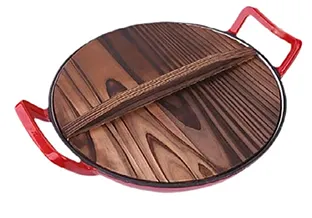
Cooking with a Dutch Oven on the Stovetop for Perfect Meals
The Versatility and Charm of Dutch Oven Cooking
When it comes to versatile kitchen tools, few can compete with the Dutch oven. This heavy, usually cast-iron pot has been a staple in kitchens for centuries, favored for its remarkable ability to distribute heat evenly and retain warmth. Whether you are simmering a stew, baking bread, or roasting a whole chicken, the Dutch oven on the stove can do it all, making it an indispensable tool for both novice and experienced cooks alike.
A Brief History
The Dutch oven’s origins date back to the 18th century, with its name likely coming from the Netherlands, where a unique method of casting iron was perfected. The design was brought to England and then to America, where it quickly became a favorite for its durability and versatility. Traditionally, these ovens were heavy, with thick walls and a tight-fitting lid, allowing for excellent heat retention and even cooking. Today, while models vary in material and design, the essential features remain beloved by chefs and home cooks.
Why Choose a Dutch Oven?
One of the primary reasons cooks love the Dutch oven is its multipurpose nature
. Here are a few of its uses1. Simmering and Braising The heavy construction of a Dutch oven allows for a stable temperature, making it perfect for simmering soups and braising meats. The lid helps to trap moisture, resulting in tender, flavorful dishes.
2. Baking Surprisingly, Dutch ovens are excellent for baking. You can use them for baking artisan bread, which benefits from the pot's ability to create steam—a crucial element for a crispy crust. Home bakers swear by the use of a Dutch oven to replicate the effects of a traditional steam oven.
3. Roasting A Dutch oven can be a great alternative to a roasting pan. Whether it’s a chicken with vegetables or a succulent pork shoulder, the Dutch oven provides even cooking and a built-in capacity to collect all the delicious drippings, which can be turned into sauces or gravies.
dutch oven stove

4. Camping and Outdoor Cooking The Dutch oven’s design makes it suitable for outdoor cooking methods, such as cooking over an open flame or in a fire pit. Many camping enthusiasts cherish the ability to create hearty meals in their Dutch ovens while enjoying the great outdoors.
Tips for Using a Dutch Oven on the Stove
While using a Dutch oven is relatively straightforward, there are a few tips and practices to keep in mind to maximize its potential
- Preheat the Dutch Oven When using it on the stove, preheating the pot is essential for achieving even cooking. This is especially important when searing meats to lock in flavors.
- Avoid Extreme Temperature Changes Cast iron is sensitive to rapid temperature changes. Avoid putting a hot Dutch oven into cold water as it can crack. Similarly, don’t heat an empty Dutch oven on high gas without any ingredients; this can lead to overheating.
- Use the Right Utensils Metal utensils can scratch the enamel of enameled Dutch ovens, if applicable, so opt for wooden or silicone tools when cooking.
- Cleaning While many newer models are dishwasher safe, hand-washing with warm, soapy water is recommended. For stubborn stuck-on food, a soak usually does the trick.
Conclusion
The Dutch oven is more than just a cooking vessel; it’s a testament to the joys of home cooking. Its ability to adapt to various cooking techniques and its iconic status in kitchens make it a beloved tool for many. Whether you're simmering a hearty chili, baking crusty bread, or roasting a Sunday dinner, the Dutch oven on the stove offers both nostalgia and functionality, making every meal a little more special. Embrace the charm of the Dutch oven, and you’ll find that it quickly becomes one of your favorite kitchen companions, bringing warmth and flavor to your family meals.
-
Season Cast Iron Perfectly with GPT-4 Turbo TipsNewsAug.01,2025
-
High Quality Cast Iron Cookware - Baixiang County Zhongda MachineryNewsAug.01,2025
-
Premium Cast Iron Pan: Durable & Perfect HeatNewsAug.01,2025
-
High Quality Kitchen Durable Black Round Cast Iron Cookware Pancake Crepe Pan-Baixiang County Zhongda Machinery Manufacturing Co., Ltd.NewsAug.01,2025
-
Cast Iron Cookware - Baixiang County Zhongda Machinery | Nonstick, Heat ResistanceNewsAug.01,2025
-
High Quality Kitchen Durable Black Round Cast Iron Cookware - Baixiang County Zhongda Machinery | Non-Stick, Heat Retention, DurableNewsJul.31,2025


